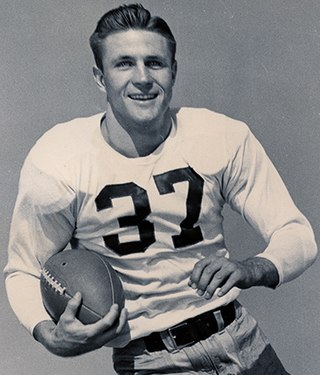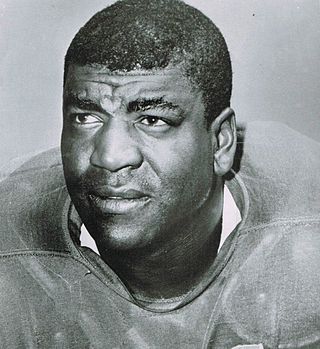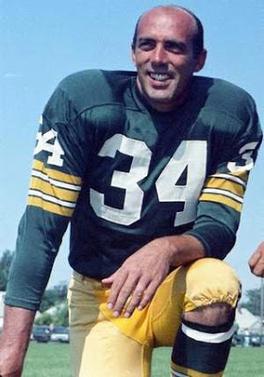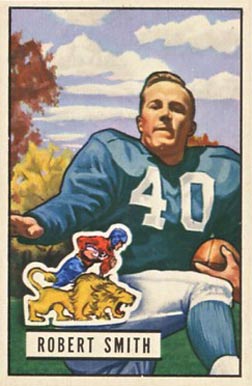
Robert Bruce St. Clair was an American professional football offensive tackle who played 11 seasons for the San Francisco 49ers of the National Football League (NFL). Known for his intelligence and towering size, at 6 ft 9 in (2.06 m) tall, St. Clair earned All-Pro honors nine times and is enshrined in the Pro Football Hall of Fame. He played college football for the San Francisco Dons and the Tulsa Golden Hurricane.

Ewell Doak Walker II was an American professional football halfback and kicker who played with the Detroit Lions of the National Football League (NFL) for six seasons from 1950 to 1955. He played college football for the SMU Mustangs, where he won the Heisman Trophy in 1948.

Richard Lane, commonly known as Dick "Night Train" Lane, was an American professional football cornerback who played for 14 years in the National Football League (NFL). He played for the Los Angeles Rams (1952–1953), the Chicago Cardinals (1954–1959), and the Detroit Lions (1960–1965).

Robert Yale Lary Sr. was an American professional football player, businessman, and politician. He played for 11 seasons as a safety, punter and return specialist for the Detroit Lions of the National Football League (NFL). He was inducted into the Pro Football Hall of Fame in 1979 and was also selected for the NFL 1950s All-Decade Team.

Jack LeRoy Christiansen was an American professional football player who became a college and pro coach. He played professionally in the National Football League (NFL) for the Detroit Lions as a safety and return specialist from 1951 to 1958. He helped lead the Lions to three NFL championships in 1952, 1953, and 1957 and was a first-team All-NFL player in six of his eight years in the league. He led the NFL in interceptions in 1953 and 1957 and in punt returns for touchdown in 1951, 1952, 1954, and 1956. His eight career punt returns for touchdowns was an NFL record until 1989 and remains the fourth best in league history. He was inducted into the Pro Football Hall of Fame in 1970.

John Henry Johnson was an American professional football player who was a running back. He was known for his excellence at the fullback position as both a runner and a blocker. His first professional stint was in Canada in the Western Interprovincial Football Union for one season with the Calgary Stampeders. He then played in the National Football League (NFL) for the San Francisco 49ers, Detroit Lions, and Pittsburgh Steelers before spending his final season in the American Football League (AFL) with the Houston Oilers. Commonly referred to as simply John Henry, an allusion to the folk hero of the same name, Johnson was a tough and tenacious player who performed at a high level well into the tail end of his career.

Reitz Memorial High School or simply Memorial High School (MHS) is an inter-parochial Catholic high school on the east side of Evansville, Indiana. It sits on land bought with money donated by Francis Joseph Reitz in 1922 in memory of his parents, John Augustus and Gertrude Reitz. The school officially opened its doors on January 5, 1925. It is part of the Diocese of Evansville.

Donald LeRoy Doll, also known as Don Burnside, was an American football player and coach.

Donald Gene "Babe" Chandler was an American professional football player who was a punter and placekicker for 12 seasons in the National Football League (NFL) in the 1950s and 1960s. Chandler played college football for the Florida Gators, and thereafter, he played professionally for the New York Giants and the Green Bay Packers of the NFL.

Robert James "Hunchy" Hoernschemeyer was an American football player. A native of Cincinnati, he played college football as a halfback for the Indiana Hoosiers football in 1943 and 1944 and as a quarterback for the Navy Midshipmen football team in 1945. He led the NCAA in both total offense and passing yards during the 1943 season.

James Robert Smith was an American football defensive back, halfback and punter. He played in the National Football League (NFL) for the Detroit Lions from 1949 to 1954. He played for NFL championship teams in Detroit in 1952 and 1953 and was selected as a first-team All Pro after the 1952 season. He also played in the All-America Football Conference (AAFC) for the Buffalo Bills (1948), Brooklyn Dodgers (1948), and Chicago Hornets (1949). Smith played college football for the Tulsa Golden Hurricane, the Iowa Pre-Flight Seahawks (1944), and the Iowa Hawkeyes (1946–1947).

Earl Francis "Jug" Girard was an American football player. He played ten seasons in the National Football League (NFL) as an end, halfback, quarterback, punter, kickoff returner, defensive back, and punt returner. He played for the Green Bay Packers (1948–1951), Detroit Lions (1952–1956), and Pittsburgh Steelers (1957). He won two NFL Championships with the Lions in 1952 and 1953. He played college football at the University of Wisconsin in 1944 and 1947 and was selected as a first-team All-American halfback at age 17 in 1944.
David Hinton Middleton was an American football end, wide receiver, and halfback.

Joseph Charles Naekauna Francis Jr. was an American football halfback and quarterback in the National Football League (NFL) and the Canadian Football League (CFL). Following his playing career, he was a high school football head coach in his native Hawaii.
The 1953 Detroit Lions season was the franchise's 24th season in the National Football League. The Lions won their second consecutive and third overall National Football League (NFL) championship. In their fourth year under head coach Buddy Parker, the Lions compiled a 10–2 record during the regular season, outscored opponents 271 to 205, finished in first place in the NFL's Western Division, and defeated the Cleveland Browns 17–16 in the NFL Championship Game at Briggs Stadium in Detroit.
Robert Fred Kercher was an American football defensive end in the National Football League (NFL) who played for the Green Bay Packers. Kercher played collegiate ball for Georgetown University and played professionally in the NFL for one season, in 1944.

The 1946 Michigan Wolverines football team represented the University of Michigan in the 1946 Big Nine Conference football season. In their ninth year under head coach was Fritz Crisler, the Wolverines compiled a 6–2–1 record, outscored opponents 233 to 73, and finished the season in second place in the Big Nine Conference and ranked No. 6 in the final 1946 AP poll. The team's two losses came against an undefeated Army team that was ranked No. 2 in the final AP poll and against an Illinois team that won the Big Nine championship and was ranked No. 5 in the final AP poll. Michigan won its last four games by a combined score of 162 to 19, starting a 25-game winning streak that continued for nearly three years until October 8, 1949. In the final game of the 1946 season, Michigan defeated Ohio State, 58–6, the Buckeyes' worst defeat since joining the conference in 1913.
The 1957 Houston Cougars football team, also known as the Houston Cougars, Houston, or UH, represented the University of Houston in the 1957 college football season. It was the 12th year of season play for Houston. The team was coached by first-year head coach Hal Lahar. The team played its games off-campus at Rice Stadium, which had been built in 1950. Houston won its third conference championship, as the Cougars earned a perfect 3–0 record in conference play. It was the first time a conference championship was achieved by a first-year coach for Houston. Despite losing several key starting players and switching head coaches, Houston was considered a favorite for the conference championship prior to the season's start. Following the season, three of Houston's players from the 1957 roster were drafted in the 1958 NFL draft. Three more 1957 players were also taken in the 1959 NFL draft.
The 1945 Indiana Hoosiers football team was an American football team that represented the Indiana University Bloomington in the 1945 Big Ten Conference football season, compiled the only undefeated record and won the first Big Ten Conference championship in the program's history. In their 12th year under head coach Bo McMillin, the Hoosiers compiled a 9–0–1 record, outscored their opponents by a combined total of 279 to 56, and finished the season ranked #4 in the final AP Poll. The lone blemish on the team's record was a 7–7 tie with Northwestern in the second game of the season.
The Million Dollar Backfield was a National Football League (NFL) offensive backfield of the San Francisco 49ers from 1954 to 1956. Featuring quarterback Y. A. Tittle, halfbacks Hugh McElhenny and John Henry Johnson, and fullback Joe Perry, the backfield was also referred to as the "Fabulous Foursome" and "Fearsome Foursome" by sportswriters. Formed well before players earned six-figure salaries, the unit was named as such for its offensive prowess, and compiled record offensive statistics. It is regarded as one of the best backfields compiled in NFL history, and is the only full house backfield to have all four of its members enshrined in the Pro Football Hall of Fame.















